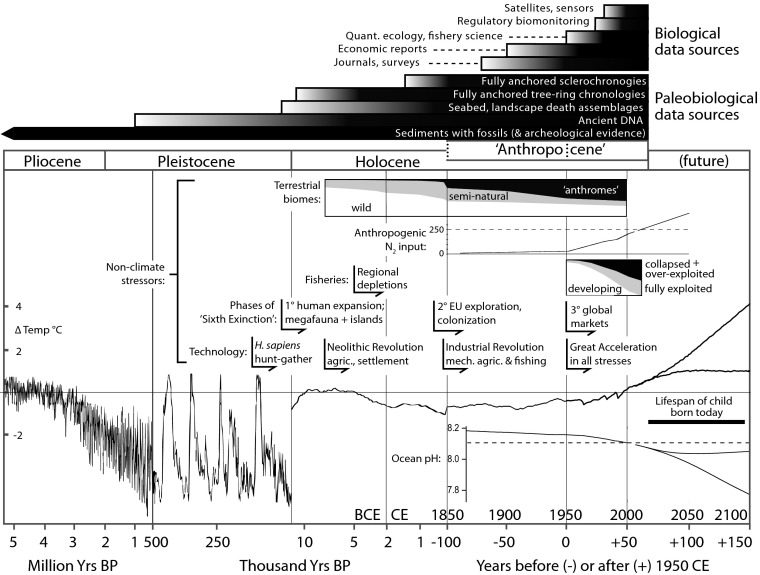Fig. 1.
Historical trends in environmental conditions and technology over the last 5 million years, culminating in the Anthropocene, when human activities achieved a global signature. Most biological data (Top) are from studies conducted after World War II, and thus short-term variability has occurred in the context of trends rather than stationary means in climate, nutrients, and other human pressures. The deeper historical reach of paleobiological data challenge assumptions of stability and equilibrium and show that many populations, species, communities, and biomes had undergone significant changes in abundance, structure, and function at regional scales well before the mid-20th century. Note changes in scale along the x axis, where the present day is operationally set at 1950 CE (radiocarbon definition). Based on signals in sedimentary records and notwithstanding earlier effects on biota, geologists will likely formalize the start of the Anthropocene Epoch either at 1950 CE (i.e., when bomb-generated radionuclides appear and isotopically depleted industrial nitrates increase strongly) or at 1850 CE, with the culmination of the Industrial Revolution in Europe and North America, when atmospheric pCO2 first reached the upper limit of Holocene variability (the previous ∼12,000 y) (2, 9). Sources are as follows: ocean pH (adapted from ref. 8); temperature anomalies from a 1961–1990 baseline for the Plio-Pleistocene (reprinted from ref. 6 with permission from AAAS), Holocene to 1850 CE (10), and post-Industrial Revolution (HarCRUT3 data from ref. 11), all lowered by 0.3 °C to fit the 1986–2005 baseline used to project future changes (reprinted with permission from ref. 12); human cultural evolution (2); land-animal extinction phases, regional fisheries (13), and catch-based global data (reprinted with permission from ref. 14); land conversion (reprinted from ref. 15, by permission of the Royal Society); and anthropogenic reactive nitrogen input to biosphere (reprinted with permission from ref. 16), which now equals total natural N2 fixation (dashed line).

